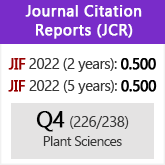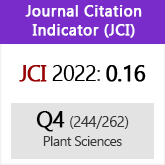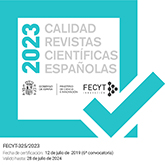Molecular phylogeny and re-assessment of some Scleroderma spp. (Gasteromycetes)
DOI:
https://doi.org/10.3989/ajbm.2199Keywords:
Boletales, ecology, ectomycorrhizal fungi, gasteromycete, Scleroderma, taxonomy, phylogenetic speciesAbstract
The fungal genus Scleroderma is cosmopolitan in temperate and tropical regions and forms ectomycorrhizal associations with a wide range of forest trees. To delimit phylogenetic Scleroderma species and identification, 43 basidiomes were chosen of different geographical origins and their rDNA internal transcribed spacer (ITS) were sequenced. Phylogenetic analyses of these sequences together with additional GenBank sequences identified 11 taxa. A strong phylogenetic pattern was observed related to a character of their basidiospore ornamentation.
Downloads
References
Binder, M. & Bresinsky, A. 2002. Derivation of a polymorphic lineage of gasteromycetes from boletoid ancestors. Mycologia 94: 85-98. doi:10.2307/3761848
Calonge, F.D. 1998. Gasteromycetes, I. Lycoperdales, Nidulariales, Phallales, Sclerodermatales, Tulostomatales. Flora Mycologica Iberica vol. 3. Real Jardín Botánico & J. Cramer. Madrid, Berlin, Stuttgart. 271 pp.
Demoulin, V. 1974. Scleroderma meridionale Demoulin et Malençon, the correct name for the large Scleroderma of Great Lakes sand dunes. The Michigan Botanist 13: 68-72.
Felsenstein, J. 1985. Confidence limits on phylogenies: An approach using the bootstrap. Evolution 39 783-791. doi:10.2307/2408678
Fries, E. 1821. Systema Mycologium. Gryphiswaldiae. 520 pp. Gardes, M. & Bruns, T.D. 1993. ITS primers with the enhanced specificity for basidiomycetes-application to the identification of mycorrhizae and rusts. Molecular Ecology 2: 113-118.
Guzmán, G. 1970. Monografia del género Scleroderma Pers. Emend. Fr. Darwiniana 16: 233-407.
Guzmán, G. & Ovrebo, C.L. 2000. New observations on sclerodermataceous fungi. Mycologia 92(1): 174-179. doi:10.2307/3761461
Hawksworth, D.L., Kirk, P.M., Sutton, B.C. & Pegler, D.N. 1995. Ainsworth and Bisby’s dictionary of the fungi, 8th edn. CAB international, Wallingford.
Huelsenbeck, J.P., Rannala, B. & Masly, J.P. 2000. Accomodating phylogenetic uncertainty in evolutionary studies. Science 288: 2349-2350. doi:10.1126/science.288.5475.2349 PMid:10875916
Huelsenbeck, J.P. & Ronquist, F. 2001. MRBAYES: Bayesian inference of phylogenetic trees. Bioinformatics 17: 754-755. doi:10.1093/bioinformatics/17.8.754 PMid:11524383
Larget, B. & Simon, D.L. 1999. Markov chain Monte Carlo algorithms for the Bayesian analysis of phylogenetic trees. Molecular Biology and Evolution 16: 750-759.
Léveillé, J.H. 1848. Fragments Mycologiques. Annales Des Sciences Naturelles (Sér. III): 119-144.
Marx, D.H. 1981. Variability in ectomycorrhizal development and growth among isolate of Pisolithus as affected by source, age and reisolation. Canadian Journal of Forest Research 11: 168-174. doi:10.1139/x81-022
Massee, G. 1889. A monograph of the British Gasteromycetes. Annual of Botany 4: 1-104.
Martin, F., Díez, J., Dell, B. & Delaruelle, C. 2002. Phylogeography of the ectomycorrhizal Pisolithus species as inferred from nuclear ribosomal DNA ITS sequences. New Phytologist 153: 345-357. doi:10.1046/j.0028-646X.2001.00313.x
Martín, M.P. & García-Figueres, F. 1999. Colletotrichum acutatum and C. gloeosporioides cause anthracnose on olives. European Journal of Plant Pathology 105: 733- 741. doi:10.1023/A:1008785703330
Martín, M.P. & Winka, N. 2000. Alternative methods of extracting and amplifying DNA from lichens. Lichenologist 32: 189-196. doi:10.1006/lich.1999.0254
Persoon, C.H. 1801. Synopsis methodica fungorum. Göttingen. 706 pp.
Rodriguez, F., Oliver, J.F., Martín, A. & Medina, J.R. 1990. The general stochastic model of nucleotide substitution. Journal of Theororetical Biology 142: 485-501. doi:10.1016/S0022-5193(05)80104-3
Ruiz-Díez, B., Rincón, A.M., de Felipe, M.R., & Fernández-Pascual, M. 2006. Molecular characterization and evaluation of mycorrhizal capacity of Suillus isolates from Central Spain for the selection of fungal inoculants. Mycorrhizas 16(7): 465-474. doi:10.1007/s00572-006-0063-8 PMid:16896798
Page, R.D.M. 1996. Treeview: an application to display phylogenetic trees on personal computers. Computer Application in the Biosciences 12: 357-358. PMid:8902363
Sambrook, J., Fritsch, E.F. & Maniatis, T. 1989. Molecular Cloning. A laboratory manual, 2nd edn. Cold Springer Habour Laboratory Press, New York.
Šebek, S. 1953. Monograph of the Central European Species of the Genus Scleroderma Pers. Sydowia 7: 158-190.
Sims, K., Watling, R. & Jeffries, P. 1995. A revised key to the genus Scleroderma. Mycotaxon 56: 403-420.
Swofford, D.L. 2003. PAUP*. Phylogenetic analysis using parsimony (*and other methods), Version 4.0b10. Sinauer Associates: Sunderland, MA, USA.
Vaillant, S. 1727. Botanicon Parisiense, [31] + XII + [4] + 205 + [12] + [1] p. XXXIII tab.; 1 portr., 1 carte.
Watling, R. & Sims, K. 2004. Taxonomic and floristic notes on some Malaysian fungi IV (Scleroderma). In: Cripps, C.L. (ed.), Fungi in Forest Ecosystems; Systematics, Diversity and Ecology. Memoirs of the New York Botanical Garden 89: 93-96.
White, T.J., Bruns, T.D., Lee, S.B. & Taylor, J.W. 1990. Amplification and direct sequencing of fungal ribosomal RNA genes for phylogenetics. PCR protocol, A guide to methods and applications. Academic press, San Diego, CA, pp. 315-321.
Downloads
Published
How to Cite
Issue
Section
License
Copyright (c) 2009 Consejo Superior de Investigaciones Científicas (CSIC)

This work is licensed under a Creative Commons Attribution 4.0 International License.
© CSIC. Manuscripts published in both the printed and online versions of this Journal are the property of Consejo Superior de Investigaciones Científicas, and quoting this source is a requirement for any partial or full reproduction.All contents of this electronic edition, except where otherwise noted, are distributed under a “Creative Commons Attribution 4.0 International” (CC BY 4.0) License. You may read here the basic information and the legal text of the license. The indication of the CC BY 4.0 License must be expressly stated in this way when necessary.
Self-archiving in repositories, personal webpages or similar, of any version other than the published by the Editor, is not allowed.

















